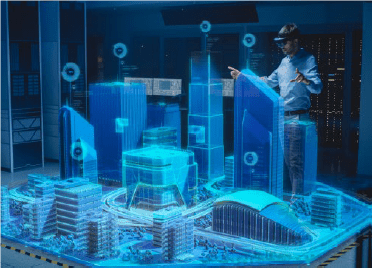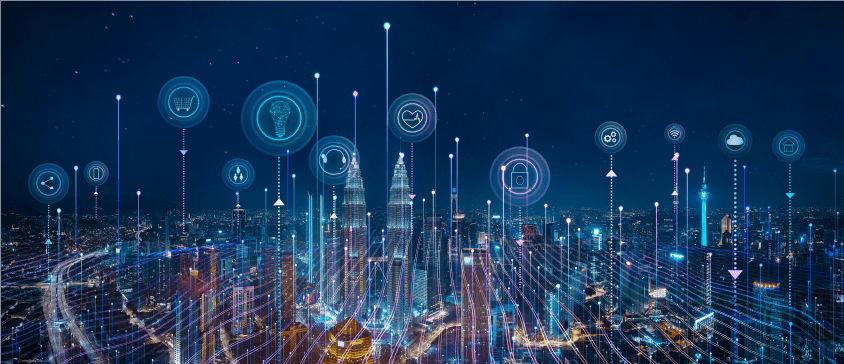A federated dataset that we might be familiar with in project delivery, generally in the form of a Navisworks model (or similar), is not the same thing as a Digital Twin. Coming from the world of BIM and Digital Engineering to an understanding of Digital Twin can, however, be challenging. A time- and location-based understanding of all assets, both physical and digital, becomes fundamental to better decision-making. This places an even greater degree of reliance on the comprehensive classification of digital assets.
A Digital Twin differs from federated data sets traditionally delivered by BIM, in that it is a database and representation or virtual model of physical assets and linked events. This ‘thing’ can be anything from a building or a power network, to a bridge or even industrial equipment. It can include elements such as water, people and vehicle movement, and is a platform through which to interrogate or exchange data.
Importantly, a Digital Twin can span the entire lifecycle of a physical asset and is enabled with real-time data, allowing machine learning and simulations to facilitate better decision making. Ultimately, this leads to more informed outcomes in the physical world and new ways to deliver services.
Common Misconceptions
As an emerging market segment, buzzwords and misconceptions about Digital Twins are rife. In particular, delineating the core features of Building Information Modelling (BIM), Digital Engineering (DE), and Digital Twins can be difficult.
We approach this in terms of capabilities:
- Building Information Modelling (BIM); Specification, management, utilisation and authoring of data rich 3D information models that document, capture and reflect the built environment through a federated data set.
- Digital Engineering (DE); Innovation, specification, management and utilisation of digital solutions within the built environment. Examples of common digital solutions encompassed under Digital Engineering include BIM, GIS, Virtual Reality and Augmented Reality.
- Digital Twin; Virtual representation of an object or system that spans its lifecycle utilising real- time data to provide a live reflection of the captured subject(s). A Digital Twin can be utilised for analysis, simulation, planning and business logic. It can be linked to digital assets in a combined platform, with a focus on data analytics and solutions that leverage machine learning.
The ability to agnostically integrate a client’s existing datasets (Data Ontology will be covered in a future instalment) or support the procurement of new elements provides the basis for a true Digital Twin experience and is essential to the development of new services and revenue streams for all data owners.
Applications

Industry Movements and International Standards
With the ever-expanding application of Digital Twins, delivery of an interconnected ecosystem will require collaboration and standardisation of datasets and the data marketplace. As such, industry and government bodies (such as the CSIRO and ANZLIC in Australia, and the Centre for Digital Built Britain in the United Kingdom) have released frameworks for the creation, use and governance of Digital Twins.
These frameworks will be bolstered by relevant International Standards that so far include:
- ISO/IEC TR 22417:2017 Information technology — Internet of things (IoT) Use cases
- ISO/IEC TR 24030 Information technology — Artificial intelligence (AI) — Use cases
- ISO/IEC AWI 30172 Digital Twin — Use cases
- ISO/IEC AWI 30173 Digital twin — Concepts and terminology
- ISO/FDIS 23-247 – 1 Automation systems and integration — Digital Twin framework for manufacturing – Part 1: Overview and general principles. This is currently under development and final text has been registered for approval. The additional parts to this standard include Part 2: Reference Architecture,
Part 3: Digital representation of manufacturing elements and Part 4: Information exchange are also underdevelopment.
These Standards and frameworks outline several common principles—open high-quality data, value, privacy, security, standards and ethics—which can help guide the creation of your Digital Twin.
Where to Start
The first step in creating your own Digital Twin is to ensure that your BIM, Digital Engineering and IoT data sets have been defined, specified, and delivered correctly. Data must be accurate, complete and readily available to flow into your Digital Twin.
Your data should be secure, private and have clear governance. It is vital that your data remains exactly that yours. Service providers should be data curators who manage and maintain data on your behalf; they should not capture your data, or hold it ransom. The process used to capture and store your data must be secure, and you should understand how and who has access to it.
Further Information
While still an emerging sector, several industry bodies have released research papers on Digital Twins. For further information, DBM Vircon recommends:
- Principles for Spatially Enabled Digital Twins of the Built and Natural Environment in Australia -released by ANZLIC
- The Gemini Principles – released by the Centre for Digital Built Britain
- Flourishing Systems – also released by the Centre for Digital Built Britain
- Framework for Spatially Enabled Digital Twins – released by the Commonwealth Scientific and Industrial Research Organisation (CSIRO)
- The Smart Cities Council ANZ is developing a Digital Twin Strategy



